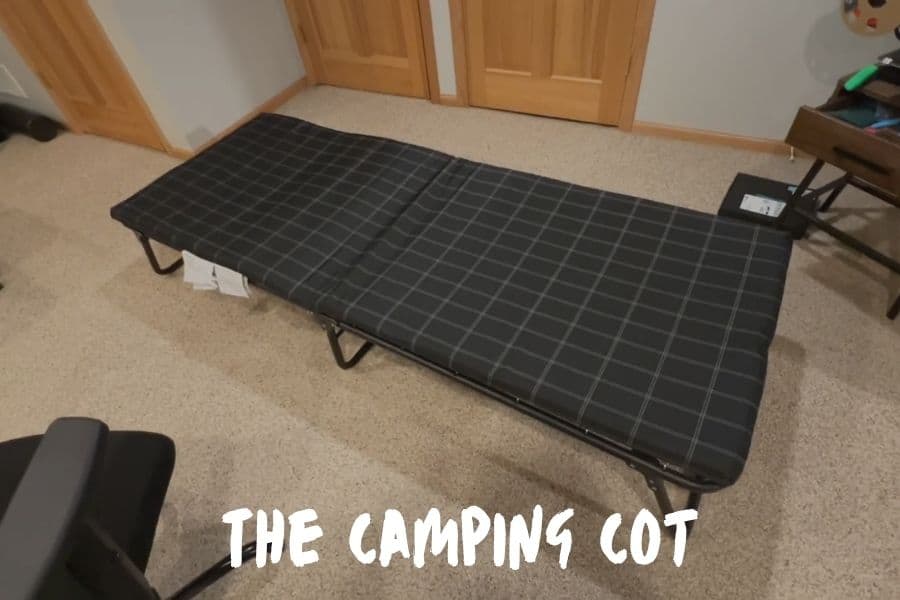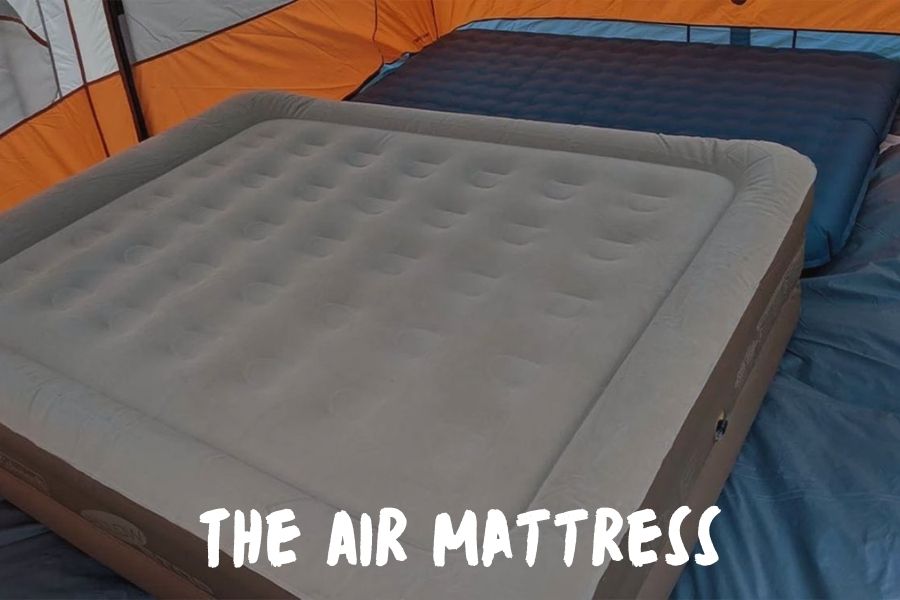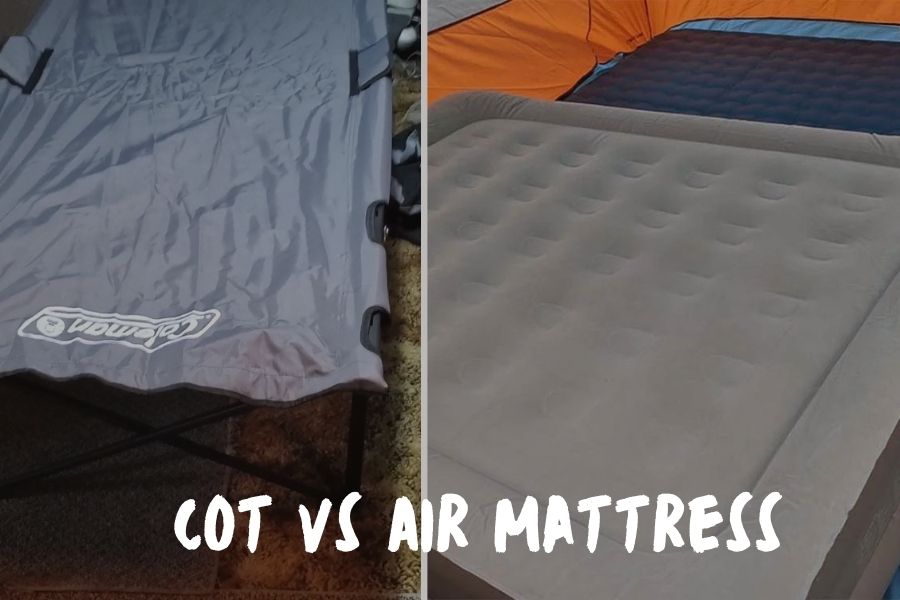For a good night’s sleep in a tent, you’ve got a few different kinds of camping beds to choose from.
Camping cots and air mattresses are two popular choices.
Both are solid options, but they each have certain pros and cons.
In this article, we’ll take a closer look at both types of camping beds, and compare them side-by-side. That way, you’ll get to see where they shine, and where their weaknesses lie.
Ladies and gentlemen, I present to you the ultimate camping bed showdown:
Cot vs air mattress – let the battle commence:
FEATURES | COT | AIR MATTRESS |
Comfort | ||
Warmth | ||
Durability | ||
Setup | ||
Space | ||
Portability | ||
Affordability |
Table of Contents
ToggleThe Camping Cot

A camping cot is a portable, fold-up bed, usually made of canvas stretched over a metal frame. Most models are made to sleep 1 person, although there are some double cot 2 person models out there.
You might have seen them in war movies, being used by the military as makeshift beds for soldiers, as well as temporary hospital beds.
The number one advantage these babies have got over other types of camping beds is the fact that they’re elevated off the ground.
This is a huge plus for a number of reasons:
First off, you’re further away from any ants, beetles, spiders, snakes or other creepy crawlies that could give you a heart attack in the middle of the night.
Also, if you encounter any heavy rain on your camping trip and your tent floods, you still won’t get wet. Well – at least not from underneath. If your rain fly fails you, you better hope you have a tarp for back up.
But, perhaps most importantly, being off the ground will keep you warmer when it’s cold and cooler when it’s hot. But, more on that further on.
Another big plus is that they provide great support. People who suffer from back pain will probably find camping cots to be a much better option than any other type of camping bed there is.
That being said, they’re very stiff, meaning that if you sleep on your side like me, you might not have the most comfortable experience sleeping on one of these.
And while we’re talking about drawbacks, there are a couple more, too:
These things can be pretty bulky and heavy when packed up. That means that getting them from place to place can be a bit of a hassle.
Plus, you’ll need a pretty large camping tent to be able to fit them inside.
One possible solution to this problem is getting a tent cot, which is a cot with its very own tent built in. If you’ve got one of these, the only other thing you need is a sleeping bag and you’re good to go.
However, these tend to be heavier and bulkier, so they won’t be suitable for use as a backpacking cot.
That being said, there are also some very lightweight and compact camping cots on the market, so if portability is high up on your list of priorities, make sure to pay attention to size and weight.
They’re also quite pricey. A good quality camp cot could set you back just as much if not more than your tent!
That being said, they will last far longer than a camping air mattress in most cases.
Pros:
- Comfortable – provide great support for people with back pain
- Elevated, keeping you off the ground warm and away from bugs and rising water
- Able to withstand harsh conditions
- Quick and easy, hassle-free setup and takedown
- Super lightweight models available that are even suitable for hiking
- The space underneath can be used to store your gear
Cons:
- Not super comfortable for side sleepers
- Won’t fit in smaller tents
- Can be fairly expensive
Get One: The 10 Best Camping Cots to Elevate Your Sleep
The Air Mattress

An air mattress is an inflatable, portable bed, usually made of PVC, or a similar type of material. They come in all different sizes, just like regular beds – from single, all the way through to queen size and even king size.
They’re pretty comfy to sleep on, and will give you a good amount of protection from any small rocks and sticks on the ground beneath you.
What’s neat about them is that you can adjust the amount of air inside, depending on your personal preference. With less air inside, you’ll get a softer mattress, and if you blow it up more, you’ll get a firmer mattress.
What about portability?
Well, they do well in this area, too. Most models are light and compact, making them easy to carry around from one place to another. That said, there are also some heavier models out there, so remember to check the weight.
Now, I hate to be a Debbie Downer, but it isn’t all sunshine and rainbows.
Here are some of the negatives:
Unfortunately, like with anything inflatable, air mattresses can rupture. If you slice your inflatable mattress on a sharp rock somewhere, you’ll end up with a big, floppy pile of fabric. Not very comfortable to sleep on, to say the least.
That’s why it’s always a good idea to have a repair kit with you, so that you can patch up your camping mattress if you need to.
On top of that, air mattresses sit directly on the ground, making it harder to stay cool when it’s hot, and harder to warm up when you’re winter camping in cold weather.
Plus, being so close to the ground makes close encounters with creepy crawlies more likely to occur.
Also, unless you have a self inflating mattress, or access to an electric or battery operated pump or air compressor, you’ll have to blow your mattress up using a manual pump, which takes a fair bit of elbow grease.
If (heaven forbid) you’re unfortunate enough to have left your pump at home, you can blow your air mattress up with your mouth. Be warned though: this is going to take a huge amount of time and effort, and will leave you out of breath and lightheaded.
Moral of the story – if you’re using an air bed, don’t forget your pump at home.
Pros:
- Adjustable firmness depending on how much you pump it up
- Not too firm even when fully pumped, making them more comfortable for side sleepers
- Most models are lightweight and compact, making them easy to carry around
- A wider range of choices available when it comes to size
- Generally quite affordable – although there are some pretty expensive models, too
Cons:
- On the ground, which means less protection from heat and cold, as well as bugs
- Don’t provide as much back support as camping cots
- Prone to ruptures that’ll leave you with a flat mattress
- Pumping them up manually takes a bit of effort
Get One: Best Camping Air Mattress (Our Top Picks)
Cot Vs Air Mattress: A Side-By-Side Comparison

Now that you’re familiar with the ins and outs of each type of camping bed, let’s take a look at how they compare to one another.
The categories we’ll use to compare them are:
- Comfort
- Warmth
- Durability
- Portability
- Setup
- Size
- Affordability
Ready to find out which one comes out on top?
FEATURES | COT | AIR MATTRESS |
Comfort | ||
Warmth | ||
Durability | ||
Setup | ||
Space | ||
Portability | ||
Affordability |
Let’s dive right in!
Comfort
What I find the most comfortable might not be the same as what you find the most comfortable.
What I can tell you is that if you have problems with your back, you should be sleeping on your back anyway. And, in that case, a cot is definitely the best option for you. They’re tight and stiff, so they provide lots of support.
If, however, you’re someone who enjoys sleeping on their side, you might find that a cot is too stiff for you. The tight canvas might be so hard that it presses into your hip bones, causing you discomfort.
For that reason, side sleepers will probably be much more comfortable on an air mattress. The same goes for tossers and turners who shift around a lot at night.
And the winner is… the camping cot for people with back pain, and the air mattress for side sleepers.
Warmth
When it comes to staying warm, camping cots have a clear advantage over air mattresses.
The reason for this is that they’re elevated off the ground.
When it’s cold, you’ll have a hard time staying warm if you’re sleeping on the cold ground. Many people believe that sleeping in a cot makes it more difficult to warm up, but this simply isn’t true.
Even though elevating yourself higher up means you’ll have cool air circulating all around you, it’ll still be easier to warm up than if you were on an air mattress or foam sleeping pad on the ground.
On the other hand, in the summer, being elevated from the ground and having cool air flowing underneath you will also make sleeping much more comfortable.
And the winner is… the camping cot!
Durability
Camping cots come up victorious again in the durability category.
As we mentioned, air mattresses can rupture, causing them to deflate and rendering them useless. Thankfully, you can repair them fairly easily, as long as you have a repair kit on hand.
Cots, on the other hand, are made of durable materials that are made to be able to withstand all kinds of conditions.
That means that even in rough weather out in the wilderness, you’ll be able to rely on your camping cot to stand strong and perform.
And the winner is… the camping cot!
Portability
Which is more portable?
Well, it depends on the model.
Both camping cots and air mattresses can be unbelievably heavy and bulky.
That said, both can be surprisingly lightweight and compact as well.
If you’re going car camping, you won’t be too concerned with a little extra weight.
However, for backpackers who need the lightest possible option, an air mattress is going to be the best choice. Some air mattresses are so light that you can barely feel them on your back.
Some camping cots, however, are also light enough to take out on the trail.
Still, not as light as an ultralight air mattress.
And the winner is… the air mattress!
Size
What takes up more space, a camping cot or an air mattress?
This is a tricky one.
Technically, camping cots take up more space. They’re taller, so you need a larger tent to begin with if you want to fit camping cots inside.
However, it isn’t that simple.
You see, when you put an air mattress down, that space is taken up and it can’t be used for anything else.
With camping cots, on the other hand, you’ve got all the space underneath them to store your gear, making it a lot easier to fit everything in your tent. P
lus, keeping your stuff under your sleeping cot gives you extra space to move around the tent.
So, when you look at it that way, air mattresses actually take up more space than camping cots at the end of the day.
And the winner is… the camping cot!
Setup
When it comes to both setup and takedown, camping cots claim another clear victory.
Their legs fold out in a jiff, and they’re up and ready to go in a matter of seconds. Folding them back up is just as quick and easy.
Air mattresses, on the other hand, need to be inflated. This means you’ll need an air pump. If you’re out in the wilderness, it probably won’t be an electric pump. So, get ready to break a sweat.
When it’s time to pack up, you need to deflate your air mattress, which also takes much longer than folding up the legs on a camping cot.
And the winner is… the camping cot!
Affordability
Finally, what everything unfortunately always comes down to – which one can you afford?
Now, air mattresses are generally a more affordable option than camping cots.
However, given the fact that camping cots are much more durable, they’ll probably last you longer. So, in a sense, a camping cot might be a better investment in the long run.
Ultimately, I’d recommend going for the option that suits you based on the other factors we discussed, unless you’re on a tight budget and you need a quick, affordable solution.
And the winner is… the air mattress in the short run, but the camping cot in the long run.
The Final Verdict
Cot vs air mattress – a sleeping system battle for the ages.
Camping cots came out on top for people with back issues, and they’re better for staying cool/warm, more durable and easier to set up and take down.
Air mattresses took the victory for side sleepers, and they’re lighter, more compact and not as expensive as camping cots.
So, think about what your camping needs are, and choose your winner.


